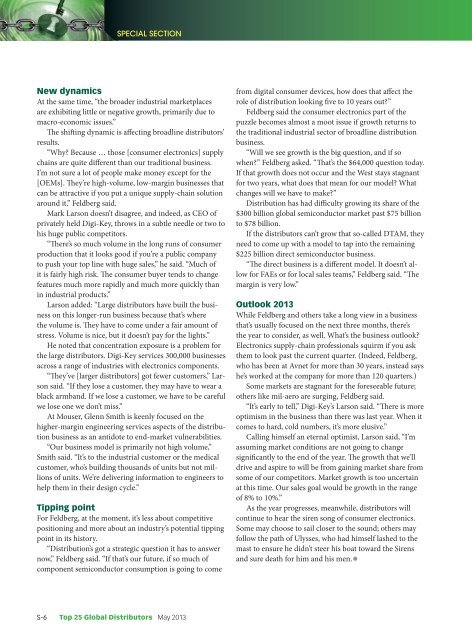201305.pdf 43279KB May 08 2013 11:07:04 PM
201305.pdf 43279KB May 08 2013 11:07:04 PM
201305.pdf 43279KB May 08 2013 11:07:04 PM
You also want an ePaper? Increase the reach of your titles
YUMPU automatically turns print PDFs into web optimized ePapers that Google loves.
Special SectionNew dynamicsAt the same time, “the broader industrial marketplacesare exhibiting little or negative growth, primarily due tomacro-economic issues.”The shifting dynamic is affecting broadline distributors’results.“Why? Because … those [consumer electronics] supplychains are quite different than our traditional business.I’m not sure a lot of people make money except for the[OEMs]. They’re high-volume, low-margin businesses thatcan be attractive if you put a unique supply-chain solutionaround it,” Feldberg said.Mark Larson doesn’t disagree, and indeed, as CEO ofprivately held Digi-Key, throws in a subtle needle or two tohis huge public competitors.“There’s so much volume in the long runs of consumerproduction that it looks good if you’re a public companyto push your top line with huge sales,” he said. “Much ofit is fairly high risk. The consumer buyer tends to changefeatures much more rapidly and much more quickly thanin industrial products.”Larson added: “Large distributors have built the businesson this longer-run business because that’s wherethe volume is. They have to come under a fair amount ofstress. Volume is nice, but it doesn’t pay for the lights.”He noted that concentration exposure is a problem forthe large distributors. Digi-Key services 300,000 businessesacross a range of industries with electronics components.“They’ve [larger distributors] got fewer customers,” Larsonsaid. “If they lose a customer, they may have to wear ablack armband. If we lose a customer, we have to be carefulwe lose one we don’t miss.”At Mouser, Glenn Smith is keenly focused on thehigher-margin engineering services aspects of the distributionbusiness as an antidote to end-market vulnerabilities.“Our business model is primarily not high volume,”Smith said. “It’s to the industrial customer or the medicalcustomer, who’s building thousands of units but not millionsof units. We’re delivering information to engineers tohelp them in their design cycle.”Tipping pointFor Feldberg, at the moment, it’s less about competitivepositioning and more about an industry’s potential tippingpoint in its history.“Distribution’s got a strategic question it has to answernow,” Feldberg said. “If that’s our future, if so much ofcomponent semiconductor consumption is going to comefrom digital consumer devices, how does that affect therole of distribution looking five to 10 years out?”Feldberg said the consumer electronics part of thepuzzle becomes almost a moot issue if growth returns tothe traditional industrial sector of broadline distributionbusiness.“Will we see growth is the big question, and if sowhen?” Feldberg asked. “That’s the $64,000 question today.If that growth does not occur and the West stays stagnantfor two years, what does that mean for our model? Whatchanges will we have to make?”Distribution has had difficulty growing its share of the$300 billion global semiconductor market past $75 billionto $78 billion.If the distributors can’t grow that so-called DTAM, theyneed to come up with a model to tap into the remaining$225 billion direct semiconductor business.“The direct business is a different model. It doesn’t allowfor FAEs or for local sales teams,” Feldberg said. “Themargin is very low.”Outlook <strong>2013</strong>While Feldberg and others take a long view in a businessthat’s usually focused on the next three months, there’sthe year to consider, as well. What’s the business outlook?Electronics supply-chain professionals squirm if you askthem to look past the current quarter. (Indeed, Feldberg,who has been at Avnet for more than 30 years, instead sayshe’s worked at the company for more than 120 quarters.)Some markets are stagnant for the foreseeable future;others like mil-aero are surging, Feldberg said.“It’s early to tell,” Digi-Key’s Larson said. “There is moreoptimism in the business than there was last year. When itcomes to hard, cold numbers, it’s more elusive.”Calling himself an eternal optimist, Larson said, “I’massuming market conditions are not going to changesignificantly to the end of the year. The growth that we’lldrive and aspire to will be from gaining market share fromsome of our competitors. Market growth is too uncertainat this time. Our sales goal would be growth in the rangeof 8% to 10%.”As the year progresses, meanwhile, distributors willcontinue to hear the siren song of consumer electronics.Some may choose to sail closer to the sound; others mayfollow the path of Ulysses, who had himself lashed to themast to ensure he didn’t steer his boat toward the Sirensand sure death for him and his men.•S-6 Top 25 Global Distributors <strong>May</strong> <strong>2013</strong>






![[270].pdf 37407KB Sep 02 2010 09:55:57 AM - ElectronicsAndBooks](https://img.yumpu.com/50350834/1/185x260/270pdf-37407kb-sep-02-2010-095557-am-electronicsandbooks.jpg?quality=85)
![draaien, A Viruly 1935 OCR c20130324 [320]. - ElectronicsAndBooks](https://img.yumpu.com/49957773/1/190x252/draaien-a-viruly-1935-ocr-c20130324-320-electronicsandbooks.jpg?quality=85)



![20051110 c20051031 [105].pdf 35001KB Feb 18 2009 08:46:32 PM](https://img.yumpu.com/48687202/1/190x253/20051110-c20051031-105pdf-35001kb-feb-18-2009-084632-pm.jpg?quality=85)




